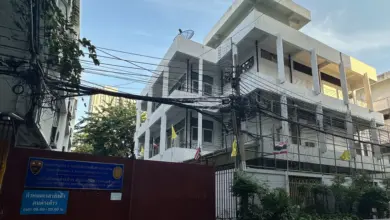
Kim’s call during a speech at a Supreme People’s Assembly (SPA) meeting in Pyongyang was the latest in a string of recent bellicose statements from the North Korean leader, including a New Year’s declaration that the North was ending a policy of seeking reconciliation with South Korea.
North Korea has also been active militarily in recent weeks, firing hundreds of artillery rounds into waters near a disputed border between North and South and testing what it said was a ballistic missile topped with a hypersonic glide vehicle.
Besides calling for the destruction of the reunification monument, Kim on Monday also said Pyongyang was abolishing all agencies for promoting cooperation with Seoul. At the same time, he called the South the North’s “primary foe and invariable principal enemy.”
While the North Korean leader’s rhetoric is strong, backing it up with the destruction of a symbolic structure constructed by his father Kim Jong Il – and one that represents the principles of his grandfather Kim Il Sung – shows decades of North Korean policy is being abandoned, experts said.
The Kim family, beginning with Kim Il Sung, has ruled North Korea since its post-World War II founding in 1948.
The North and South remain technically at war, but both sides have long declared an ultimate goal of one day peacefully reunifying the peninsula and viewed each other as members of the same family.
But Kim’s most recent rhetoric moves away from the goal of reunification and instead is increasingly portraying South Korea as an implacable foe.
“Yesterday’s speech shows that Kim Jong Un is establishing his own way of unification based on power, breaking Kim Il Sung and Kim Jong Il’s legacy,” said Jeong Eun-mee, research fellow at the Korea Institute for National Unification.
“Demolition of the monument symbolically shows this,” she said.
Straddling the Reunification Highway between Pyongyang and the demilitarized zone separating the North and South, the nine-story arch called the Monument to the Three Charters for National Reunification was completed in 2001 after two years of construction.
It symbolizes the efforts of Kim Jong Il and Kim Il Sung to set guidelines for uniting North and South Korea.
Kim Jong Un on Monday declared an emphatic end to reunification thinking.
“We should completely remove the eyesore ‘Monument to the Three Charters for National Reunification’ … and take other measures so as to completely eliminate such concepts as ‘reunification,’ ‘reconciliation’ and ‘fellow countrymen’ from the national history of our Republic,” Kim is quoted as saying by KCNA.
Leif-Eric Easley, a professor at Ehwa University in Seoul, said breaking with the unification policies of his father and grandfather showed “Kim is sending a strong domestic message that North Korea’s challenges are externally driven.”
Rejecting peaceful reunification
One of the parts of Kim Jong Il’s three charters, and a principle introduced by Kim Il Sung into North Korean policy in the 1970s, was that “national reunification should be achieved by peaceful means without resorting to arms.”
But Kim on Monday said the North, officially known as the Democratic People’s Republic of Korea (DPRK) “does not want war, but we also have no intention of avoiding it.”
The North Korean leader said that “the danger of the outbreak of a war to be caused by a physical clash has considerably aggravated,” and he vowed that if war happens, the North would take the entire peninsula by force.
At the same meeting at which Kim spoke, North Korea’s Parliament announced the abolishment of the Committee for the Peaceful Reunification of the Country, the National Economic Cooperation Bureau and the Kumgangsan International Tourism Administration, entities all designed for cooperation with the Republic of Korea (ROK), South Korea’s official name.
“It is a serious anachronistic mistake to regard the ROK as a partner for reconciliation and reunification any longer as it declared the DPRK as a ‘principal enemy’ and is seeking only an opportunity for ‘bringing down the government’ and achieving ’unification by absorption,’” KCNA said.
South Korea’s 2022 Defense White Paper, published in early 2023, included a line saying: “the North Korean regime and the North Korean military are our enemy,” for the first time in six years.
South Korea not backing off
On Tuesday, South Korean leader Yoon Suk Yeol said his government will not be cowed by Kim’s latest threats.
“If North Korea provokes, we will punish them multiple times as hard,” Yoon said at a Cabinet meeting in Seoul.
Yoon noted that Kim Jong Un declared the Northern Limit Line (NLL), a disputed de facto border drawn up by the United Nations at the end of the Korean War in 1953, to be illegal.
Yoon on Tuesday called Kim’s rejection of the NLL “a political provocative act to crack South Korea and make our people nervous.”
The NLL runs three nautical miles from the North Korean coastline and puts five islands close to the coast under South Korean control. Earlier this month, North Korea fired around 200 artillery rounds that fell within a maritime buffer zone near it.
North Korea has previously rejected the NLL and proposed a different line – one that would roughly extend the DMZ southwest out into the Yellow Sea, rather than hug the North Korean shoreline.
Yoon, who has taken a much harder line on North Korea than his predecessors, said the South’s quarrel was with the Kim regime, not the people of North Korea.
The South Korean constitution defines all Koreans on the peninsula as equal, with northerners entitled to the same rights as southerners, and Yoon said Tuesday the South would welcome defectors from the North.
“The government will not spare attention and support for the defectors to settle well in our society,” Yoon said.




